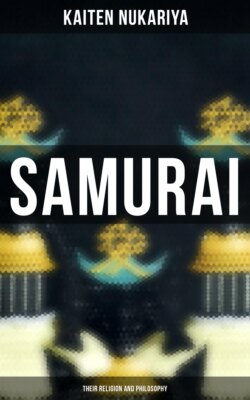Читать книгу Samurai: Their Religion and Philosophy - Kaiten Nukariya - Страница 32
На сайте Литреса книга снята с продажи.
12. Zen under the Toku-gana Shogunate.
ОглавлениеPeace was at last restored by Iye-yasu, the founder of the Toku-gana Shogunate (1603-1867). During this period the Shogunate gave countenance to Buddhism on one hand, acknowledging it as the state religion, bestowing rich property to large monasteries, making priests take rank over common people, ordering every householder to build a Buddhist altar in his house; while, on the other hand, it did everything to extirpate Christianity, introduced in the previous period (1544). All this paralyzed the missionary spirit of the Buddhists, and put all the sects in dormant state. As for Zen98 it was still favoured by feudal lords and their vassals, and almost all provincial lords embraced the faith.
It was about the middle of this period that the forty-seven vassals of Ako displayed the spirit of the Samurai by their perseverance, self-sacrifice, and loyalty, taking vengeance on the enemy of their deceased lord. The leader of these men, the tragic tales of whom can never be told or heard without tears, was Yoshi-o (O-ishi died 1702), a believer of Zen,99 and his tomb in the cemetery of the temple of Sen-gaku-ji, Tokyo, is daily visited by hundreds of his admirers. Most of the professional swordsmen forming a class in these days practised Zen. Mune-nori100(Ya-gyu), for instance, established his reputation by the combination of Zen and the fencing art.
The following story about Boku-den (Tsuka-hara), a great swordsman, fully illustrates this tendency:
"On a certain occasion Boku-den took a ferry to cross over the Yabase in the province of Omi. There was among the passengers a Samurai, tall and square-shouldered, apparently an experienced fencer. He behaved rudely toward the fellow-passengers, and talked so much of his own dexterity in the art that Boku-den, provoked by his brag, broke silence. 'You seem, my friend, to practise the art in order to conquer the enemy, but I do it in order not to be conquered,' said Boku-den. 'O monk,' demanded the man, as Boku-den was clad like a Zen monk, 'what school of swordsmanship do you belong to?' Well, mine is the Conquering-enemy-without-fighting-school.' 'Don't tell a fib, old monk. If you could conquer the enemy without fighting, what then is your sword for?' 'My sword is not to kill, but to save,' said Boku-den, making use of Zen phrases; 'my art is transmitted from mind to mind.' 'Now then, come, monk,' challenged the man, 'let us see, right at this moment, who is the victor, you or I.' The gauntlet was picked up without hesitation. 'But we must not fight,' said Boku-den, 'in the ferry, lest the passengers should be hurt. Yonder a small island you see. There we shall decide the contest.' To this proposal the man agreed, and the boat was pulled to that island. No sooner had the boat reached the shore than the man jumped over to the land, and cried: 'Come on, monk, quick, quick!' Boku-den, however, slowly rising, said: 'Do not hasten to lose your head. It is a rule of my school to prepare slowly for fighting, keeping the soul in the abdomen.' So saying he snatched the oar from the boatman and rowed the boat back to some distance, leaving the man alone, who, stamping the ground madly, cried out: 'O, you fly, monk, you coward. Come, old monk!' 'Now listen,' said Boku-den, 'this is the secret art of the Conquering-enemy-without-fighting-school. Beware that you do not forget it, nor tell it to anybody else.' Thus, getting rid of the brawling fellow, Boku-den and his fellow-passengers safely landed on the opposite shore."101 The O Baku School of Zen was introduced by Yin Yuen (In-gen) who crossed the sea in 1654, accompanied by many able disciples.102 The Shogunate gave him a tract of land at Uji, near Kyo-to, and in 1659 he built there a monastery noted for its Chinese style of architecture, now known as O-baku-san. The teachers of the same school103 came one after another from China, and Zen104 peculiar to them, flourished a short while.
The O Baku School is the amalgamation of Zen and the worship of Amitabha, and different from the other two schools. The statistics for 1911 give the following figures:
The Number of Temples:
The So To School 14,255
The Rin Zai School 6,128
The O Baku School 546
The Number of Teachers:
The So To School 9,576
The Rin Zai School 4,523
The O Baku School 349
It was also in this period that Zen gained a great influence on the popular literature characterized by the shortest form of poetical composition. This was done through the genius of Ba-sho,105 a great literary man, recluse and traveller, who, as his writings show us, made no small progress in the study of Zen. Again, it was made use of by the teachers of popular106 ethics, who did a great deal in the education of the lower classes. In this way Zen and its peculiar taste gradually found its way into the arts of peace, such as literature, fine art, tea-ceremony, cookery, gardening, architecture, and at last it has permeated through every fibre of Japanese life.
